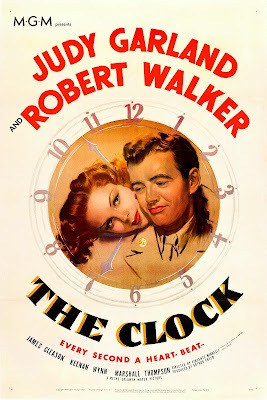Counting Down the Hours with “The Clock”

I’m discovering that, in tough societal times like these, Itruly appreciate movies that take me to an earlier era. It’s good to see thatpeople can survive—even thrive—during dark days. Perhaps that’s why I’ve reactedso positively to The Clock, a 1945 romantic drama directed by VincenteMinnelli and starring his soon-to-be wife, Judy Garland, in her firstnon-singing dramatic role. Set against the backdrop of World War II, TheClock gives a happy ending to a tale that is best described as pure wish-fulfillmentfantasy.
The Clock begins with boyish-looking Robert Walker,in full military uniform, arriving at New York’s Grand Central Station. He’s ayoung American G.I., on weekend leave from training camp, and he’s come to the BigApple to look around. I couldn’t help comparingthis opening section to the naïve young sailors on shore leave in a great 1945musical—and subsequent 1949 film—On the Town, which like The Clock celebratesromance but hints at a world war always lurking in the background.
It’s quicklyestablished that Walker’s character, Joe, is a small-town fellow, one who’sencountering for the first time such wonders as an escalator. While hanging outaimlessly in the station, he accidentally trips a pert young lady, whose heelsnaps off of her stylish spectator pump. Mortified, Joe manages to get the shoerepaired, then wonders if he can tag along with its wearer (who of course isGarland) as she heads home from work. Garland’s Alice is naturally wary of thisstranger. But she’s a good-hearted soul and finally agrees to meet him fordinner. Their rendezvous spot: under the clock in the lobby of the AstorHotel.
The clock, of course, soon becomes a symbol of the swiftpassage of time. As the two get to know each other, a dinner date turns into aromantic walk in Central Park. (The camera’s s-l-o-w build-up to the first bigkiss is rather hilarious.) Suddenly it’s midnight, too late for Alice to catcha bus back to her working-class neighborhood. Cabs, as always in NYC, arenearly impossible to get, so Al, a friendly milkman making early morningdeliveries, offers them a ride in his van. But the van gets a flat tire; thethree enter an all-night café to call Al’s company; a drunk attacks poor Al andknocks him out. After the van is repaired, Joe takes over the driving, and heand Alice work together to make all the deliveries on Joe’s route in recordtime. Joe, now recovered, invites them to his home for breakfast; his loyalwife greets them warmly, and the conversation turns to the homey joys ofmarried life.
Now it’s Saturday morning, and the pair have agreed to spendtogether the waning hours before Joe’searly Sunday departure. Enter the challenges of the New York subway system. Ina crowded station, Alice is forced onto a train car, leaving Joe behind. Theirsearch for each other becomes frantic (if only they had cell phones!), mademore desperate by the fact that they don’t know one another’s full names. But, since this is a fairy-tale, they do atlast reunite—and agree that they never want to be parted again. And so theytake steps to make their love permanent, via matrimony.
It's the love-conquers-all ending we’re rooting for, onethat I’m sure was highly necessary in wartime. By 2025 standards, though, thelovers seem painfully naïve. Ironically,both Garland and Walker found no lasting happiness in marriage. Both turned todrink and drugs, and died young.
Published on September 23, 2025 22:04
No comments have been added yet.
Beverly in Movieland
I write twice weekly, covering topics relating to movies, moviemaking, and growing up Hollywood-adjacent. I believe that movies can change lives, and I'm always happy to hear from readers who'd like t
I write twice weekly, covering topics relating to movies, moviemaking, and growing up Hollywood-adjacent. I believe that movies can change lives, and I'm always happy to hear from readers who'd like to discuss that point.
...more
- Beverly Gray's profile
- 10 followers



